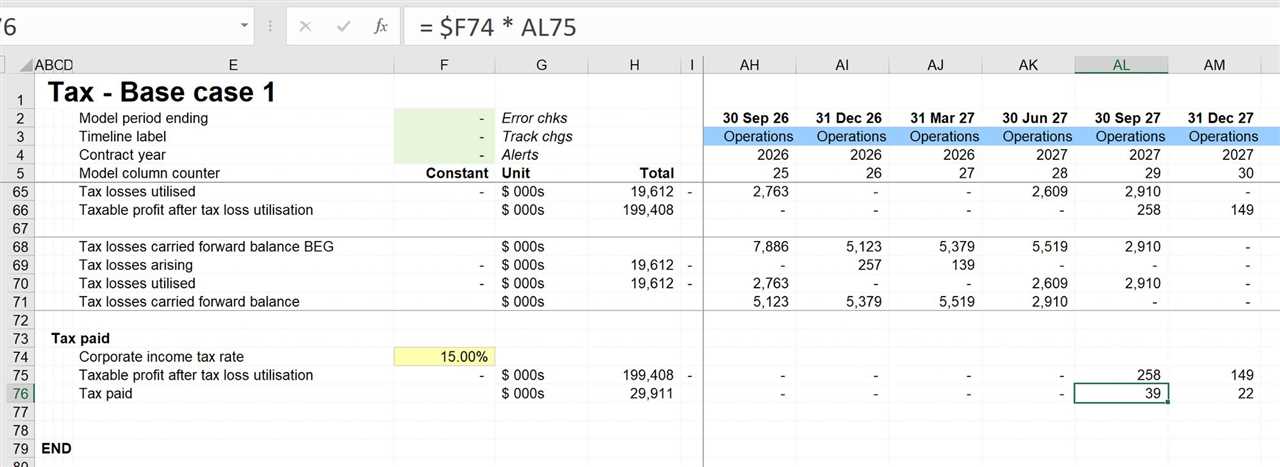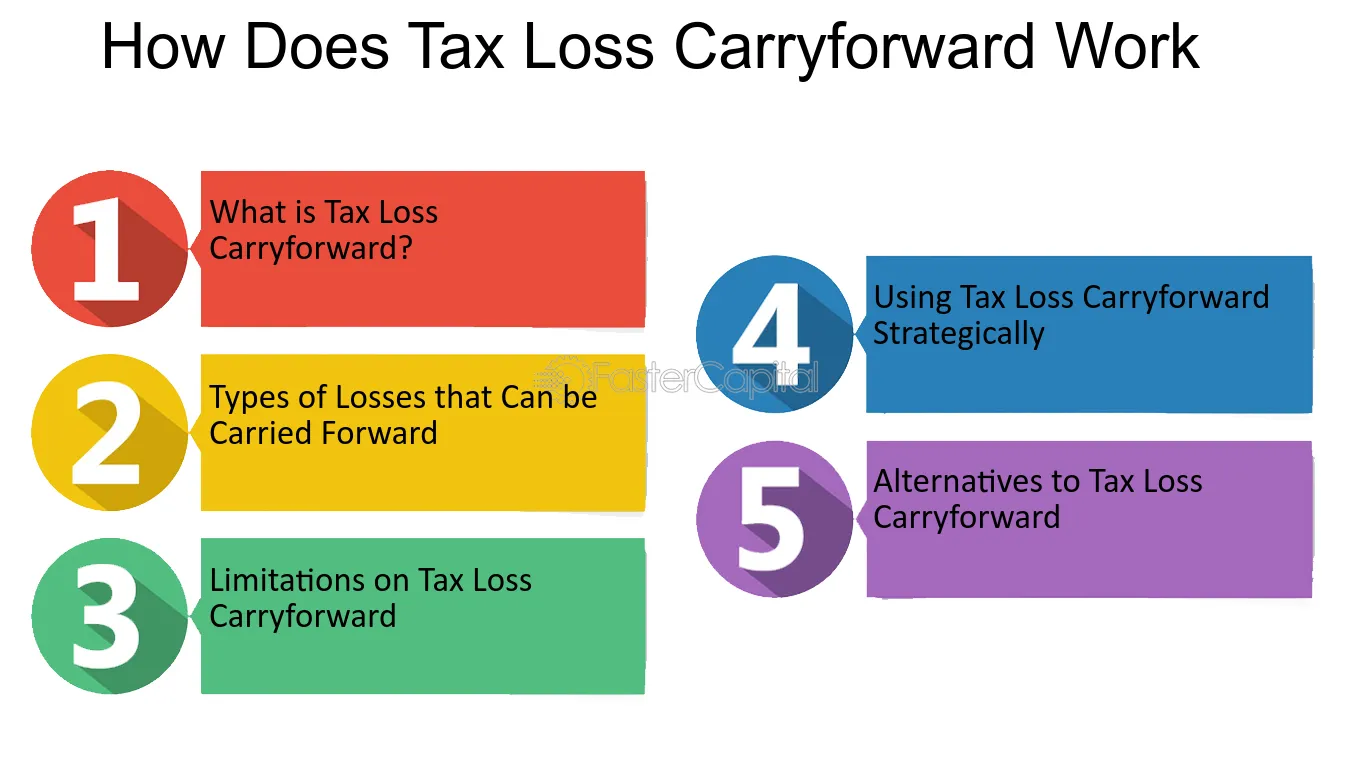Mechanics of Tax Loss Carryforward

When a business incurs a net operating loss (NOL) in a particular tax year, it can carry forward that loss to offset taxable income in future years. This allows the business to reduce its tax liability and potentially receive a tax refund.
To utilize tax loss carryforward, businesses must follow certain rules and regulations set by the tax authorities. These rules may vary depending on the jurisdiction, so it is important for businesses to consult with tax professionals or accountants to ensure compliance.
One key aspect of tax loss carryforward is the carryforward period. This refers to the number of years that a business can carry forward its losses. In many jurisdictions, the carryforward period is typically limited to a certain number of years, such as 5 or 10 years. After this period, any remaining losses may expire and cannot be used to offset future taxable income.
It is also important to note that tax loss carryforward can only be used to offset taxable income, not to reduce other types of taxes such as payroll taxes or sales taxes. Additionally, businesses may be subject to certain limitations or restrictions on the amount of losses that can be carried forward in a given year.
When utilizing tax loss carryforward, businesses must keep detailed records of their losses and properly report them on their tax returns. This includes providing supporting documentation and calculations to substantiate the claimed losses.
Different Types of Tax Loss Carryforward
1. Net Operating Loss (NOL) Carryforward: This is the most common type of tax loss carryforward and is available to both businesses and individuals. NOL carryforward allows you to offset future taxable income with losses incurred in previous years. The carryforward period for NOLs is typically 20 years, but it can vary depending on the specific tax laws of the country or jurisdiction.
2. Capital Loss Carryforward: This type of tax loss carryforward applies specifically to losses incurred from the sale of capital assets, such as stocks, bonds, or real estate. Capital losses can be carried forward indefinitely until they are fully utilized to offset capital gains. However, there are usually limitations on the amount of capital losses that can be deducted in a given year.
3. Passive Activity Loss (PAL) Carryforward: PAL carryforward applies to losses incurred from passive activities, such as rental properties or limited partnerships. These losses can only be used to offset income from passive activities in future years. The carryforward period for PALs is usually unlimited, but there may be limitations on the amount that can be deducted in a given year.
4. Foreign Tax Credit Carryforward: This type of tax loss carryforward applies to foreign taxes paid or accrued in previous years. It allows businesses and individuals to offset their US tax liability by the amount of foreign taxes paid. The carryforward period for foreign tax credits is typically 10 years, but it can vary depending on the specific tax laws and treaties between countries.
5. Alternative Minimum Tax (AMT) Credit Carryforward: AMT credit carryforward applies to unused AMT credits from previous years. The AMT is a separate tax system that applies to individuals and corporations with high income or certain types of deductions. Any unused AMT credits can be carried forward and used to offset regular tax liability in future years.
6. Excess Business Loss Carryforward: This type of tax loss carryforward applies specifically to losses incurred by non-corporate businesses, such as sole proprietorships, partnerships, and S corporations. The Tax Cuts and Jobs Act (TCJA) introduced a limitation on the amount of excess business losses that can be deducted in a given year, but any unused losses can be carried forward indefinitely.
Benefits of Tax Loss Carryforward
1. Tax Savings

One of the primary benefits of tax loss carryforward is the potential for tax savings. By utilizing this strategy, businesses can reduce their taxable income in future years, which in turn lowers their tax liability. This can result in significant savings, especially for businesses that have experienced substantial losses in previous years.
2. Smoothing Income Fluctuations

Another advantage of tax loss carryforward is that it helps businesses smooth out their income fluctuations. Many businesses experience periods of both profitability and losses, and being able to carry forward losses allows them to offset future profits and stabilize their taxable income. This can be particularly beneficial for businesses in industries that are prone to cyclical or seasonal fluctuations.
By using tax loss carryforward, businesses can avoid paying higher taxes during profitable years and instead use their losses to offset those profits. This helps to create a more consistent and predictable tax liability, making it easier for businesses to plan and budget for their tax obligations.
3. Encouraging Risk-Taking and Innovation
Tax loss carryforward also encourages risk-taking and innovation in the business world. By allowing businesses to offset losses against future profits, it provides a safety net for entrepreneurs and encourages them to take calculated risks and invest in new ventures.
Knowing that losses can be carried forward and used to offset future profits reduces the fear of failure and encourages businesses to pursue innovative ideas and strategies. This can lead to increased entrepreneurship, job creation, and economic growth.
4. Long-Term Planning

Lastly, tax loss carryforward allows businesses to engage in long-term financial planning. By carrying forward losses, businesses can strategically manage their taxable income over multiple years, taking into account future projections and goals.
This long-term planning can help businesses make informed decisions about investments, expansion, and other financial strategies. It provides a level of flexibility and control over their tax liability, allowing businesses to optimize their financial position and maximize their overall profitability.
Real-Life Examples of Tax Loss Carryforward
- Startup Company: A newly established tech startup incurs significant losses in its first few years of operation due to high research and development costs. These losses can be carried forward and offset against future profits once the company becomes profitable. This allows the startup to reduce its tax liability and reinvest the saved funds into further growth and development.
- Real Estate Investment: An individual invests in rental properties and experiences losses due to high expenses and low rental income. These losses can be carried forward and offset against future rental income or capital gains from the sale of properties. This helps reduce the overall tax burden on the individual and provides financial flexibility for future investments.
- Business Expansion: A well-established manufacturing company decides to expand its operations by opening a new production facility. The initial years of the expansion result in losses due to high setup costs and low sales volume. These losses can be carried forward and offset against future profits from the expanded operations. This allows the company to minimize its tax liability during the expansion phase and allocate more resources towards growth and development.
- Stock Market Losses: An individual invests in stocks and experiences significant losses due to market downturns. These capital losses can be carried forward and offset against future capital gains from the sale of stocks. This helps reduce the tax liability on future investment gains and provides an opportunity for the individual to recover from the initial losses.
These examples demonstrate how tax loss carryforward can be a valuable tool for businesses and individuals to manage their tax liabilities and optimize their financial strategies. By utilizing tax loss carryforward, entities can turn temporary losses into long-term tax benefits, allowing for greater financial stability and growth.

Emily Bibb simplifies finance through bestselling books and articles, bridging complex concepts for everyday understanding. Engaging audiences via social media, she shares insights for financial success. Active in seminars and philanthropy, Bibb aims to create a more financially informed society, driven by her passion for empowering others.
